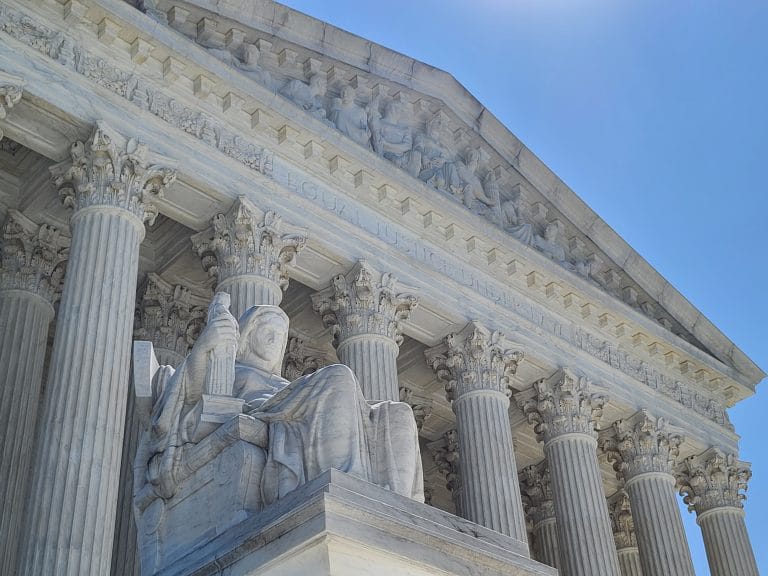The Supreme Court officially heard oral arguments in its latest big Second Amendment case on Tuesday. There were hints at which way they plan to come down on the future of the federal gun ban for domestic violence restraining orders.
Over the more than 90 minutes of back and forth between the nine justices and the attorneys on either side, it became clear that most of the Court was uncomfortable with the idea of Zackey Rahimi—who was found by a judge to pose a violent threat to his girlfriend and is accused of a string of other violent crimes—being allowed to possess a firearm.
“You don’t have any doubt that your client is a dangerous person, do you?” Chief Justice John Roberts asked Mr. Rahimi’s lawyer, J. Matthew Wright. After Wright questioned what the Chief Justice meant by “dangerous,” Roberts replied, “Well, it means someone who’s shooting, you know, at people. That’s a good start.”
While the rest of the arguments were more complicated and involved other legal questions than that one exchange, it nevertheless represented what turned out to be the defining theme of the day.
Even the Court’s more conservative justices, including Samuel Alito and Bruen-test author Clarence Thomas, offered little pushback on the Government’s desire to disarm specific categories of people aside from a few questions surrounding the procedural protections afforded through the common issuance of restraining orders.
The biggest question in Rahimi, then, does not appear to be whether the Supreme Court will overturn the Fifth Circuit’s ruling and uphold section 922(g)(8). Instead, the bigger question appears to be how the Court plans to do so and whether it will offer guidance on how other courts should evaluate other gun prohibitions moving forward.
A “Responsibility” Test?
As in Roberts’ question, the concept of “dangerousness” loomed large throughout the oral argument. That principle likely holds the key to how the Court plans to issue its decision.
Both the Government and Rahimi’s lawyers agree that the country’s tradition of gun regulation is missing a “historical twin” for the modern-day gun ban for those under domestic violence restraining orders. That means to uphold the law, the Court will have to analogize to some other Founding-era history and tradition of disarmament.
Solicitor General Elizabeth Prelogar argued that the Court should uphold the ban based on a tradition of allowing governments to disarm individuals who are not “law-abiding or responsible.”
“Throughout our nation’s history, legislatures have disarmed those who have committed serious criminal conduct or whose access to guns poses a danger, for example, loyalists, rebels, minors, individuals with mental illness, felons, and drug addicts,” she said.
Several of the justices, however, bristled at the notion of identifying a tradition of disarmament based on “responsibility.”
“What if someone is categorized as irresponsible for not storing firearms properly?” Justice Thomas asked.
“Responsibility is a very broad concept,” Chief Justice Roberts added. “It seems to me that the problem with responsibility is that it’s extremely broad, and what seems irresponsible to some people might seem like not a big deal to others.”
But after some further back and forth, Prelogar retreated. She said the Government was merely using “law-abiding” and “responsible” as a stand-in for someone “whose possession of firearms presents an unusual danger beyond the ordinary citizen.” This narrower understanding of responsibility as a measure of dangerousness—rather than as a subjective judgment of virtuousness—was something the justices began to coalesce around.
“I mean, I think there would be little dispute that someone who was guilty, say, or even had a restraining order — that domestic violence is dangerous, okay. So, someone who poses a risk of domestic violence is dangerous,” Justice Amy Coney Barrett said.
Even Rahimi’s lawyer conceded that history supported arms rights being removed from certain people based on a finding of dangerousness—though he disputed whether that history applied to his client and if arms rights could be curtailed in the home.
One path the Court could take is finding that Mr. Rahimi can be disarmed based on a historical tradition of disarming dangerous people without adopting the sweeping “responsibility” standard. That would address the question of whether disarming people who have been specifically determined to pose a danger in a restraining order proceeding is allowed, but it would leave questions surrounding who else is allowed to be disarmed largely unanswered.
Justice Neil Gorsuch, for his part, seemed particularly sympathetic to the idea of issuing a narrower ruling. The bulk of his exchanges with the attorneys on both sides focused primarily on the limits case at hand and why due process concerns and other specific critiques of 922(g)(8) should be left to other cases.
A “Dangerousness” Test?
A separate course of action, one much farther reaching in scope, would be for the Court to establish a broader principle of dangerousness that would instruct future courts and implicate those other disarmament cases.
“How does the government go about showing whether certain behavior qualifies as dangerous?” Justice Barrett asked. “Because this might be in a heartland, but then you can imagine more marginal cases.”
Some of those more “marginal cases” came up by name during the oral argument. Range v. Garland, a case involving a Pennsylvania man with a nearly 30-year-old conviction for lying on a food stamp application who sued to have his gun rights restored, was explicitly cited in an exchange between Justice Barrett and the Solicitor General. The Third Circuit struck down the federal prohibition on felons possessing firearms as applied to Mr. Range in June, and the Government has asked the Supreme Court to weigh in.
Solicitor General Prelogar conceded that her desire for the Court to set a disarmament standard based on “law-abiding” and “responsible” as its guiding principles was so that “dangerous” people like Mr. Rahimi would fail the responsible prong while convicted felons, whether violent or non-violent like Range, would fail the law-abiding prong.
“We think that there are additional arguments that can be made to defend felon disarmament and that those depend on the unique history and tradition with respect to criminal conduct,” she said. “And so we would hope to have the opportunity to present those arguments and perhaps persuade you in a future case.”
Justice Barrett previously articulated a historical framework for disarming certain individuals based on dangerousness alone in a dissenting opinion when she was on the Seventh Circuit Court of Appeals. If enough of the other justices also feel that “dangerousness” should be the sole determinative factor supported by history for disarming someone, the Court could issue an opinion establishing as much.
That would solve the question in this case and significantly impact the legal analysis in cases like Range and many of the other challenges to the federal gun prohibitions percolating up through the lower courts. It would undoubtedly be a far more impactful decision.
Uncertainty Remains
To be sure, it’s important to be cautious about drawing sweeping conclusions based on the tenor of oral arguments alone. While they can be illuminating, they do not always tell the whole story. In the Bruen oral arguments over New York’s gun permitting regime, for instance, Chief Justice John Roberts seemed to question the logic of allowing any permitting whatsoever for public gun carry.
“Regardless of what the right is, it would be surprising to have it depend upon a permit system,” he said. “You can say that the right is limited in a particular way, just as First Amendment rights are limited, but the idea that you need a license to exercise the right, I think, is unusual in the context of the Bill of Rights.”
Taken on their own, these comments seem to suggest the Chief Justice was open to making permitless carry the law of the land. But when the Bruen decision was handed down, Roberts joined a concurrence from Justice Brett Kavanaugh, strongly emphasizing that the Court’s decision was not to be understood as casting legal doubt on permitting regimes that are objective and neutrally applied to all applicants.
But the overall tenor of the oral arguments in Rahimi left an unmistakable impression. Many legal experts agreed, long before the Court ever heard the case, that preservation of the federal domestic violence gun ban was the to be the likely outcome. The fact that most of the justices devoted precious little time to probing any potential infirmities in the federal statute during questioning and mainly focused on the proper standard for upholding it only lends credence to those predictions.
It would be a shock if the Justices were to affirm the Fifth Circuit after Tuesday’s oral arguments. What’s less clear is how much of an appetite the Court has at this point for expounding on the test it set last year in Bruen.






